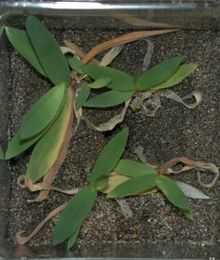Dichanthelium lanuginosum
From Wikipedia, the free encyclopedia
| Dichanthelium lanuginosum | |
|---|---|
 | |
| Scientific classification | |
| Kingdom: | Plantae |
| (unranked): | Angiosperms |
| (unranked): | Monocots |
| (unranked): | Commelinids |
| Order: | Poales |
| Family: | Poaceae |
| Genus: | Dichanthelium |
| Species: | D. lanuginosum |
| Binomial name | |
| Dichanthelium lanuginosum | |
Dichanthelium lanuginosum (Panic grass) is a species of grass. It grows in geothermal areas of Yellowstone National Park, USA. It is able to withstand high temperatures and high acidity in its rhizosphere.[1] In 2007 it was found that the heat tolerance is conferred to the grass by a symbiosis between a fungus and a virus. When it is colonised by the fungus Curvularia protuberata and the fungus is in turn colonised by a particular virus, the grass is able to tolerate soil temperatures of up to 65°C that would otherwise be lethal.[2]
References
- ↑ Stout, R. G.; Stout R. G., Summers M. L., Kerstetter T., McDermott T. R. (1997). "Heat- and acid-tolerance of a grass commonly found in geothermal areas within Yellowstone National Park". Plant science 130 (1): 1–9. doi:10.1016/S0168-9452(97)00205-7. ISSN 0168-9452.
- ↑ Márquez, Luis; Regina Redman, Russell Rodriguez, Marilyn J. Roossinck (2007). "A Virus in a Fungus in a Plant: Three-Way Symbiosis Required for Thermal Tolerance". Science 315 (5811): 513–5. doi:10.1126/science.1136237. PMID 17255511.
This article is issued from Wikipedia. The text is available under the Creative Commons Attribution/Share Alike; additional terms may apply for the media files.